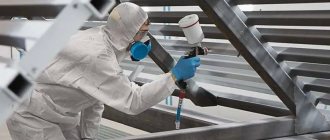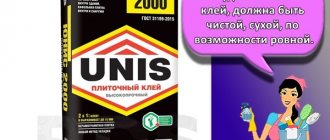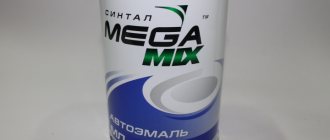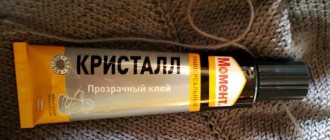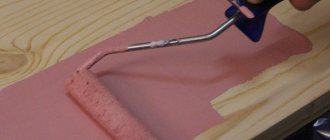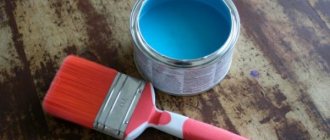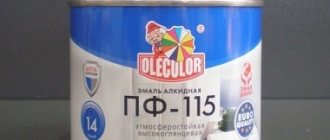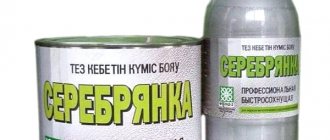Developed in the mid-70s. of the last century, alkyd enamel PF-115 meets modern requirements in terms of technical characteristics. The material is suitable for painting metal or wooden structures located indoors and outdoors. Additional advantages are the coating's resistance to ultraviolet light and good hiding power.
PF-115 enamel, developed in the 70s of the last century, is well suited for painting wooden structures.
GOST and certificate of conformity
Oil paint PF-115 is produced in accordance with GOST 6465, developed by the USSR Ministry of Chemical Industry. The standard was put into effect in mid-1977 by a resolution of the State Committee for Standards. Over the subsequent years, the documentation has undergone several editions; the adjustments made did not affect the standard number.
Each manufacturer receives a certificate with a limited validity period. The document confirms the compliance of paints and varnishes with the requirements.
Some companies issue certificates in accordance with Russian GOST R 51691-2008, which describes the general requirements for paints and enamels (on any basis). Regardless of the standard, the document indicates the name and address of the manufacturer and a list of test reports. The additional field lists the timing of inspection control (to verify compliance of production conditions and product characteristics with requirements).
Chemical composition, marking, colors of PF-115
PF enamel belongs to alkyd paints. Read more about alkyd paints here
The regulatory document that once determined the optimal combination of components included in this alkyd paint was GOST No. 6465-76. This standard is used to check the quality of a composition before allowing it to be sold. It is also allowed to produce pentaphthalic enamel according to specifications developed independently by manufacturers. This affects the cost and may affect the quality of the coating.
From a chemical point of view, alkyd paint-enamel PF-115 is a suspension, which includes:
- solvent;
- pentaphthalic varnish;
- titanium dioxide;
- color pigments.
Depending on the color, the proportion of components changes.
- According to technical characteristics, PF 115 white enamel contains: pentafle varnish 28%, titanium dioxide 62%, white spirit 10%;
- Gray – pentafle varnish 20%, titanium dioxide 75%, white spirit 4.5%, carbon black 0.5%;
- Blue – pentafle varnish 26%, titanium dioxide 60%, white spirit 4%, glaze 4%, zinc white 6%.
The production of enamel in accordance with GOST requires careful adherence to proportions, which ensures the most effective use. High-quality alkyd paint can be used both in combination with a primer and as a separate material to create a reliable coating.
Marking
When painting, it is important to choose the right enamel. For ease of orientation, manufacturers use generally accepted markings indicated on the label of the paint container. Thus, the standard designation for universal alkyd enamel PF-115 has five components:
- the name of the type of paint coating – in our case it is paint;
- abbreviation (PF), implying the presence of pentaphthalic-based varnish in the composition;
- digital key. In this case, it is the number 115, where the first digit means that the material is suitable for exterior painting or restoration work, and the last two reflect the chemical composition that complies with GOST.
Color palette PF-115
According to GOST standard No. 6465-75, alkyd paint PF-115 can be produced in 24 different shades. The most popular colors from this list are gray, white and blue. Compositions for color paints are developed on the basis of specifications. Each brand, depending on the manufacturer, has its own specifics and recipe.
However, taking into account the growing popularity of paint and its demand in various modern design solutions, a much wider palette of colored pentaphthalic enamels has appeared. Today you can choose almost any exotic color corresponding to the RAL catalog - from cherry to pistachio. The prestige and cost of such paints is higher than that of standard ones.
Composition of pentaphthalic paint
The material includes:
- rutile type titanium dioxide TiO2 suspension;
- additional fillers to change fluidity;
- pigments that determine color (for example, yellow or black);
- driers that accelerate polymerization;
- alkyd varnish (solvent).
The percentage of components depends on the shade of the paint material. The ingredients are mixed at the factory in a special tank, and then the liquid is packaged with the batch number indicated. When purchasing several cans, you must select containers from the same series, otherwise you will need to mix materials in a tank with an increased volume. When applying paint produced in different work shifts, shade deviations are possible (allowed by the standard and not a sign of defects).
The pigments that make up the enamel determine its color.
Types of enamel paint
Today, matte (115m) and glossy alkyd paint based on PF-115 is available on the market, which is used in construction and renovation work and is suitable for any painting projects.
Modern manufacturers produce two main types of oil paint PF-115, the technical characteristics of which differ in the specific application.
There are industrial and household paints - the first are supplied for industrial needs and are produced in a concentrated state, and the second are aimed at the retail consumer. They already contain a solvent to reduce the time of preliminary preparation before painting - however, the enamel will still have to be diluted before use.
The packaging of PF-115 enamel also depends on the intended purpose - you can find both small liter jars and capacious containers for industrial use.
Technical characteristics of enamel
In accordance with the standard, paints of the PF-115 series have 2 quality gradations (highest and first grade). OKP codes are used to separate materials. For example, gray enamel of the highest category has the identifier 231222053900, and the first is assigned the index 231222043903. Please note that paints in red, cherry and black colors are supplied only in accordance with the standards of the first grade.
To dilute materials to working viscosity, solvent or nefras is used (reagents must meet the requirements of GOST 1928 and 3134, respectively).
It is allowed to use pure turpentine or a mixture with solvent or white spirit in a mass ratio of 1:1. If the layer is to be applied in an electrostatic field, then the enamel is diluted with RE-4V or RE-3V solvent.
After polymerization, the paint coating has a uniform surface without defects and cracks; the standard allows for the appearance of slight shagreen. The gloss factor calculated using a photoelectric measuring device is 50 and 60% (for first and highest grades, respectively). Viscosity ranges from 60 to 120 units (depending on the shade and category). Measurements are taken at an ambient temperature of +20°C by feeding through a sprayer with a nozzle with a diameter of 4 mm.
The percentage of non-volatile substances depends on the type of material and shade, ranging from 49 to 70%, particle size is 10-25 microns. When diluted to a consistency suitable for a spray gun, up to 30% of the solvent must be introduced into the enamel. The polymerization time depends on the color; for interior work it is better not to use enamels in cherry and red shades, which require 48 hours to harden. Other materials of the PF-115 series dry within a day. The elasticity of the resulting film when bending does not exceed 1 mm (regardless of the type).
To assess the resistance of the layer to impact loads, a pendulum ball device is used. According to the requirements, the coating should not be deformed when struck from a distance of 400-500 mm. Under a layer of water at an ambient temperature of +20°C, premium grade paint does not deteriorate for 10 hours (materials of the first category do not withstand 120 minutes).
The standard requires resistance to the influence of a 0.5% cleaning solution for 15 minutes; transformer oils should not destroy the layer when applied for 24 hours.
In industrial conditions, it is allowed to dry the paint in a chamber with air heated to +105°...+110°C for 60 minutes. The standard regulates the primary colors of PF-115, but manufacturers can produce materials with individual tinting (for example, based on control samples provided by the customer). To determine the shade, methods regulated by the GOST 29319 standard are used.
Which manufacturer is better?
Without exaggeration, PF 115 enamel can be called legendary, which is why a large number of enterprises are engaged in its production. Below are the results of tests conducted by independent experts.
The drying time of enamels produced by POLIFARB and ZEBRA is practically the same and ranges from 20 to 23 hours, in addition, these enamels are easy to apply;
In the process of painting with enamels produced by DekArt, BARVA and DELFI, problems arise with uniformity of coloring, elimination of drips, streaks and brush marks;
All manufacturers provide high quality gloss, but special mention should be made of ZEBRA and MALVA;
Reliable information on paint consumption is provided by ZEBRA and MALVA.
The tests were carried out on the basis of the Physico-Mechanical Institute named after. G. V. Karpenko NAS of Ukraine.”
Depending on the color and class of enamel, the price of 1 kg can be from 60 to 170 rubles. You can find out more about the prices for the required paint on the website of the online store whose services you have decided to use.
Scope of application of enamel
Scope of material application:
- painting of building structures made of wood;
- application to walls of premises subject to regular wet cleaning;
- protection of metal products operated in various meteorological conditions.
Enamel is used to paint structures made of wood.
The versatility of enamel allows you to work indoors. For example, PF-115 is used for painting steel pipes and radiators of heating systems; the material does not peel off or turn yellow when exposed to elevated temperatures. When using, the low abrasion resistance of the paint layer should be taken into account. PF-115 is not intended for application to floor coverings or structures exposed to external abrasive influences.
PF series enamels are not designed for use at elevated temperatures. For example, do not apply the material to metal roofs or fences that are exposed to direct sunlight. The paint retains its strength and adheres to the base when heated to +60°C. Temperature stability does not depend on the number of layers and type of primer applied to the products.
Benefits of use
Main advantages of enamel:
- low cost;
- resistance to external weather influences;
- the ability to operate painted products in conditions of high humidity;
- increased service life of the paintwork;
- low specific consumption (subject to preliminary priming of the surface);
- high adhesion to the base, cleared of loose fragments;
- resistance to temperature deformation and cracking.
Disadvantages of PF-115
Disadvantages of the material noted by the masters:
- long polymerization period (at least 24 hours);
- applying the next layer is possible only after the previous one has hardened;
- increased toxicity and fire hazard of vapors and the paint itself;
- unpleasant odor when solvent evaporates;
- limited temperature stability;
- low abrasive strength;
- excessive density of the layer, which after polymerization does not allow water vapor to pass through.
An unpleasant odor during solvent evaporation is one of the disadvantages of using PF-115 enamel.
How to work with PF-115 enamel
Preparing the surface for applying PF-115 paint
Proper preparation helps prevent the formation of unevenness and peeling, and ensure a neat, decorative appearance of the surface. Main stages of work:
- cleaning Remove old paint, dust, grease and other contaminants from the surface. For this, use soda or soap solution, washing powder or other means (depending on the type of dirt). Clean metal surfaces from rust, and treat wooden surfaces with sandpaper. Pentaphthalic compounds can be applied over old paint, but the surface must be thoroughly sanded;
- drying. During the warm season, it is carried out naturally; in the cold season, heat guns can be used. Drying time depends on the material; pay special attention to drying porous surfaces (concrete, plaster);
- padding. The metal is treated with a degreasing compound, then with an anti-corrosion primer. A universal varnish, a specialized primer or drying oil is applied to the wood. Alkyd primers are suitable for porous materials.
Painting with PF-115 enamel
For painting, use the usual painting tools: rollers, brushes, brushes, spray guns. The choice of type and size of tools depends on the dimensions and configuration of the structures or surfaces to be processed. Small parts can be dip painted. The recommended temperature for applying PF-115 enamel is 5–35 °C. Work order:
- paint preparation. Open the jar, dilute the enamel with solvent if necessary, stir with a wooden stick until smooth;
- application. Distribute the paint evenly over the surface to be treated using a roller, brush or other tool of your choice;
- drying. Usually it is carried out under natural conditions. The process can be accelerated by using heat guns or other heating equipment (but the temperature of such processing should not exceed 100–110 ° C).
To ensure maximum quality, PF-115 enamel is applied in several layers. Each subsequent layer is applied after the previous one has dried, and the total amount depends on the nature of the surface:
- metal – at least 2 layers;
- concrete, brick, plaster, wood - 2–3 layers, each 20 ± 3 mm thick.
The color of the paint and its proximity to the shade of the surface being painted also matters.
What should the enamel be like?
Enamel that meets the standards should not have a strong odor. The formation of an insoluble film on the surface is not allowed. If the paint is partially dry, it is recommended to purchase a new can. It should be remembered that it is impossible to dissolve frozen fragments; when applied with a brush or roller, pieces of film will remain on the surface.
When assessing quality, you should take into account how long it takes for the applied test smear to dry. The drying time for PF-115 to touch-free, regardless of brand and shade, should not exceed 8-10 hours.
High-quality enamel has a uniform structure; during long-term storage, components can be separated by specific gravity. The paint has the standard smell of an organic solvent; there are no spots of a different color or clots on the surface. After stirring the material with a mixer or hand tool, the paint should flow evenly from the surface of the tool.
Disadvantages of PF-115 enamel
- Fire hazard. This paint is flammable, so it must be protected from open flame sources.
- Characteristic smell. For this reason, and also because of some toxicity, it is necessary to ensure good ventilation when working with PF-115, use a respirator and other personal protective equipment.
- Drying time. The process lasts about a day, and at temperatures below 20 ° C it takes even longer, which not all users like.
- Difficulty in laundering. After drying, enamel paint PF-115 is difficult to remove, including from painting tools and work clothes.
Learn more about use
Before starting use, you should familiarize yourself with:
- safety regulations;
- a list of solvents and enamel dilution technology;
- mass consumption of material per 1 m² of surface (to calculate the need);
- a list of tools and devices necessary to perform the work;
- rules for applying and choosing a paint scheme;
- standards for selecting the type of paint depending on the characteristics of surfaces;
- storage conditions of the material.
Safety precautions
Basic rules when using paint:
- Since the material contains organic solvents, the enamels of the PF-115 series belong to the category of fire hazardous and toxic substances. For example, turpentine vapors ignite already at +34°C, and spontaneous combustion occurs when heated to +300°C. When applying with a brush or spray gun, the use of open flame sources is not allowed.
- Emitted vapors of solvents penetrate the human body through the mucous membranes of the eyes, skin and respiratory tract. Work must be performed in ventilated areas using protective clothing and a respirator. To ensure air exchange, it is allowed to use artificial ventilation (for example, an electric hood). Indoors, it is necessary to open windows and doors; the risk of street dust or fluff from plants sticking to painted surfaces should be taken into account.
- The components contained in the material must not enter the sewerage system, onto the ground or into water bodies. The remaining paint must be disposed of in metal packaging as hazardous waste. If the container is cleared of traces of enamel, then disposal of the products together with household waste is allowed.
- If spilled paint ignites, it is necessary to use sand or a felt made of non-flammable fabric material to extinguish. It is permissible to use foam or carbon dioxide fire extinguishers or sprinkler extinguishing systems with a spray of tap water.
It is strictly forbidden to use enamel near an open flame source.
Dilution of pentaphthalic enamel
Manufacturers supply the paint ready for application, but during long-term storage or before refilling the sprayer, the material must be diluted. Thick enamel clogs the nozzle channels and does not provide uniform coverage of surfaces.
The volatility of the solvent has a slight effect on the hardening time (deviation within 2-4 hours). For PF-115, petroleum-based liquids (for example, solvent or white spirit) or special materials RE-4V or RE-3V are used.
Sequence of actions for breeding:
- Open the paint container and mix the material by hand or with an electric mixer.
- Add solvent; if the volume of the factory container is insufficient, then the components must be poured into a container with increased capacity.
- Stir the solution until a homogeneous mass is obtained. Pigment clumps are not allowed, since lumps clog the spray nozzle and reduce the quality of the coating when using a brush or roller. It is recommended to use an electric drill with a mixer. With a manual technique, clots may remain in the structure of the material. Select the rotation speed of the device experimentally; the tool should not splash paint over the edge of the container.
Paint consumption depending on shade
When using PF-115, you should take into account the floating consumption when painting, depending on the shade. The reason for the different results is the uneven size of the filler fraction. Material costs are influenced by the application method and surface characteristics. For example, untreated wood, brick or porous concrete will absorb some of the enamel, requiring a repeat pass with a brush or spray.
Required Tools
To apply the paint layer the following can be used:
- brush with synthetic or natural bristles - the width is selected depending on the size of the surfaces;
- felt roller with a standard handle or with an extension rod for painting walls at a great distance from the ground;
- pneumatic spray gun with electric compressor and pressure regulator;
- baths with liquid paint and a manipulator that immerses parts in the solution (used in industrial settings).
When processing surfaces, a separate paint reservoir may be required (for example, to ensure uniform wetting of the roller). To prepare liquid enamel before filling it into the spray tank, you will need a container with a volume of 1-2 liters. When painting indoor surfaces, it is necessary to use a protective material for the floor or interior items (for example, plastic film or old wallpaper).
To apply the paint layer, it is recommended to use a brush with synthetic or natural bristles.
Rules for working with paint
When applying the coating you must:
- Inspect surfaces that are free from oil stains or traces of moisture. Please note that painting is carried out at a relative air humidity of less than 80%. It is not allowed to use the material in cold weather (minimum ambient temperature +5°C). If the requirements are violated, the polymerization time increases and adhesion deteriorates.
- If there is dirt on the surface or peeling of the old paint coating, it is necessary to clean it (for example, using an abrasive tool). Wooden products should be impregnated with antiseptic primer to prevent rotting and mold formation. If work is carried out indoors, then use diluted enamel as a primer (solvent share no more than 10%). Clean metal structures with sandpaper or steel brush from traces of corrosion, wash with a degreasing compound and apply a layer of primer.
Painting schemes
Since PF-115 enamel is universal, application of the material in any direction is allowed. The master needs to control the uniformity of the layer on the surface and avoid the formation of clots. It should be noted that liquid paint can flow down vertical or inclined walls during the hardening process, so you should control the volume of applied enamel.
Selection of enamel depending on the surface
If the base has a dark shade, then several layers of enamel will be required. Otherwise, after polymerization, unpainted areas may remain on the surface.
A second coat requires 10-15% less enamel, but before applying it is necessary to wait 24 hours for the primary coating to polymerize.
When using a spray gun, some of the material is sprayed into the air, which leads to increased paint consumption, but provides a smooth surface without foreign inclusions (for example, brush lint).
Storage conditions
Packaged in sealed containers, the paint can withstand transportation and storage in rooms with negative air temperatures. Frost resistance is not regulated by the standard, but the material should not be cooled to -20°C or lower. Storage near heat sources is not allowed, since at elevated temperatures some of the solvent evaporates with the formation of clots or a dense film on the surface. Manufacturers allow paint to be stored for 24 months from the date of packaging, subject to climatic conditions.
Paint application and consumption
Pentaphthalic paint is a universal material. It can be used, as already noted, for painting surfaces made of metal, wood, for external and internal work. The composition can be applied in various ways: with brushes or brushes, pouring, dipping, spraying. The mixture consumption is on average from 100 to 180 ml per 1 sq. m. m.
Consumption depends on paint color, density, and also on the area of the surface being treated. GOST 6456-76 indicates how much area can be processed for 1 kg of material depending on the color:
- white paint, weight 1 kg – area from 7 to 10 m2;
- black – from 17 to 20 m2;
- blue or light blue – from 11 to 14 m2;
- brown – from 13 to 16 m2;
- red – from 5 to 10 m2.
The peculiarity of PF 115 paint is its hiding power characteristics. Due to this, the average material consumption per 1 m2 is on average no more than 100 g. Larger consumption is only in special cases. The material fits perfectly on brick surfaces, concrete, and metal products. But in the case of brick and concrete, it is necessary to paint in several, usually two layers. In this case, the first layer must dry for 24 hours before applying the second layer.
You can paint anything indoors. But these materials are not recommended for floors due to their poor resistance to mechanical loads and force.
On the video: the area of application of enamel and approximate consumption.
Compatibility with other dyes
PF enamels are compatible with putty of the GF, KF, MS and PF series. It is not allowed to apply paint to NC, PE and CV materials due to low adhesion and chemical incompatibility. The enamel swells and moves away from the base. Mixing PF-115 with paints and varnishes based on acrylic, melamine or polyurethane is not allowed.
PF-115 enamel is compatible with the GF series primer.
The main advantages of PF-115 enamel
- Moisture resistance. The coating withstands direct contact with water, precipitation, and protects the painted surface from corrosion.
- Economical. The consumption of enamel paint is 140 ± 40 g/m2 and depends on the method of application, type of surface, etc.
- Resistant to fading. PF-115 paint is resistant to ultraviolet rays, so the coating does not fade or fade.
- Resistance to chemical influences. This means that painted surfaces can be cleaned using detergents.
- Versatility. PF-115 is suitable for various surfaces, perfectly combined with decorative plaster, varnished wood, etc.
- Affordability. With its high technical characteristics, enamel paint PF-115 is inexpensive compared to many other paintwork materials.
Cost of enamel
The average price of the material starts from 50 rubles. per 1 kg (for wholesale quantities weighing more than 1000 kg). A jar weighing 2.5 kg (manufactured by Tex) will cost a retail buyer 770-800 rubles. A tank weighing 0.9 kg has a cost in the range of 240-180 rubles. There are budget manufacturers (for example the Formula brand) offering 1.9-kilogram cans at a price of 390 rubles. Some building materials stores hold sales, in which case the buyer can save up to 10-15% of the starting price.
Operating parameters of paintwork materials
The wide range of application and demand for painting various surfaces is determined by the technical characteristics of PF-115 enamel:
- Resistant to fading in direct sunlight.
- Does not crack due to temperature changes and strong winds.
- Does not lose properties due to precipitation.
- The presentable appearance does not deteriorate when in contact with fuels and lubricants and cleaning chemicals.
- It has good adhesion and hiding power.
- A wide range of colors and tinting options are available.
- Long service life of the painted surface.
- Structures treated with paint acquire a durable glossy finish.
The specific hardness of the layer is 0.15 – 0.25 conventional units. The drying time for painted products at an air temperature of 20 ºС is up to 24 hours. The enamel retains its performance properties in the temperature range from minus 50 ºС to plus 60 ºС. The paint is easy to apply using a variety of tools.
Popular manufacturers
Paints of the PF-115 series are produced by several companies. The materials differ in density and proportion of dry components, the number of shades depends on the manufacturer. Packages weighing up to 50 kg are offered, which allows the client to paint a large area in a single color. To reduce material consumption, it is recommended to clean the surfaces from contamination and cover them with a layer of primer. No manufacturer offers modified PF-115 enamel suitable for floor treatment (it is recommended to use wear-resistant paint PF-266 or analogues).
“Lakra”
Lakra brand enamel is supplied in cans weighing from 1 to 50 kg. Please note that the manufacturer uses containers with different parameters for different shades. The material contains crushed micronized marble, which improves the characteristics of the paint layer after polymerization. The production program includes materials of 20 colors (glossy type), white enamel with a matte effect is provided.
The manufacturer “Lakra” uses containers with different parameters for different shades.
Optimum
The Optimum brand belongs to the Tex company; the enamel is supplied in metal cans weighing from 0.9 to 2.7 kg. The manufacturer offers white paint in containers weighing 10 kg; upon special orders, the materials are packaged in packaging weighing 20 kg. After applying the paints (a total of 18 shades are produced), a glossy surface is formed; matte white enamel is present in the product line. According to the plant, the layer retains its integrity for 5 years (subject to compliance with the application technology).
Characteristics:
- consumption for single-layer application – 1 kg is enough for 7-11 m²;
- share of dry components – 74%;
- type of solvent – white spirit;
- Touch-free polymerization time is at least 5 hours.
“Bio”
Paints from the manufacturer “BioKhim” (St. Petersburg) are supplied in containers weighing from 1.2 kg. The enamel is applied manually or using a pneumatic sprayer. The amount of solvent depends on the painting technology; the polymerization time is set at 24 hours. Another manufacturer of materials with the prefix “Bio” is Doktor Farbe. A colloidal solution of silver particles has been introduced into the enamel, which makes it possible to increase the antimicrobial effect of the paint and varnish coating.
The material from Doktor Farbe (the brand belongs to the KVIL company) is suitable for use in children's and medical institutions. Before application, you should clarify how to dilute the paint with antibacterial additives. Since the additional components are based on an inorganic base, the use of white spirit or solvent is allowed.
"Prestige"
Enamel from the Prestige company is supplied in metal cans and buckets weighing from 0.4 to 50 kg. The manufacturer offers 33 basic shades; it is possible to tint the desired color by introducing 10% pigment into the white paint. The product is supplied ready for application, but before starting work the material should be mixed (dilution with solvent or white spirit is allowed, the proportion of the solution is no more than 5%).
Technical specifications:
- consumption – from 0.1 to 0.18 kg/m²;
- coating service life – up to 7 years;
- application temperature – from +5 to +35°С;
- Drying time – 24 hours (regardless of shade).
The enamel from the manufacturer “Prestige” has a drying time of 24 hours (regardless of the shade).
“Hacienda”
The Fazenda brand belongs to the Tex company. The company offers enamels of the PF-115 series (12 basic shades, including chocolate and lime) in metal containers weighing up to 20 kg. Since the materials are intended for budget repairs, the durability of the coating is reduced to 3 years. Enamels are designed for painting metal and wooden structures, but are not suitable for floors due to insufficient wear resistance. The manufacturer guarantees the stability of the paint characteristics for 24 months, provided that the storage rules and sealed containers are followed.
Material characteristics:
- consumption rate for 1 layer – from 0.06 to 0.17 kg/m²;
- density – from 1.35 to 1.45 kg/l;
- share of dry ingredients – 75%;
- solvent brand – white spirit;
- polymerization time from dust (at +20°C) – from 6 to 8 hours.
The manufacturer indicates that to increase the service life to 3 years for outdoor use, it is necessary to coat metal structures with anti-corrosion primer GF-021. Wooden parts can be treated with putty, which reduces the absorption coefficient. After polymerization, the paint layer becomes moisture resistant and is not destroyed by denatured alcohol, white spirit or turpentine.
“Tex”
PF-115 enamel from the Tex company, intended for work on metal and wood, is supplied in cans with a sealed lid weighing from 0.9 to 24 kg. The manufacturer ships the material ready for application, dust accumulation stops after 5-7 hours, the service life of the glossy paintwork reaches up to 6 years. 11 primary colors are offered; the client can obtain additional shades on his own (the proportion is calculated using a special calculator).
Main characteristics:
- consumption per 1 m2 - from 0.09 to 0.14 kg (depending on the application method and the absorbency of the base);
- dry residue share – 74%;
- density – from 1.2 to 1.4 kg/l (depending on the volume of solvent).
Areas of use
Where PF-115 enamel is used, mainly for painting windows, doors, and central heating radiators. Also, due to its high weather resistance, this enamel is excellent for working with outdoor objects, in particular metal and wooden structures, which include verandas, gazebos, fences, benches, and other utility structures. This enamel is distinguished by good moisture resistance, which is provided by a protective film that can hold the enamel on the painted surface. This will allow you not to worry that after application the paint will begin to settle, or bubbles may appear on its surface, spoiling its appearance. A significant advantage in favor of this type of enamel is also its ability to withstand the effects of ultraviolet radiation. Thanks to this, the paint does not fade for a long time.
The scope of application of PF-115 enamel is quite wide; its characteristics make it suitable for working on surfaces such as plasterboard, brick, concrete, as well as metal and wood.
Safety precautions when working with paints and varnishes
PF-115 enamel is characterized by a long service life, subject to storage conditions. Due to flammability, it is prohibited to store paint cans near open flames. Protection from ultraviolet radiation and high humidity must be provided. The manufacturer guarantees the safety of technical characteristics in the temperature range -40 ºС…+40 ºС. The packaging must be sealed to prevent the paint from drying out.
When working with alkyd enamel, it is recommended to use personal protective equipment to prevent the suspension from coming into contact with the skin. The use of goggles, gloves, and respirators for respiratory protection is required.
Individual protection means
If paint gets on your skin, wash it with soap and water. When performing interior work, it is necessary to ensure effective natural or forced ventilation. It is prohibited to paint hot surfaces and structures located near open fire.
Preparatory operations and features of using PF-115 paint
In order to ensure an even, high-quality paint coating, the surface must be carefully prepared before applying PF-115 enamel. The work is performed in the following sequence:
- Mechanical cleaning. Using special tools and cleaning products, dirt, layers of peeling paint and other contaminants are removed.
- Degreasing is in progress.
- The surface is leveled and completely dried.
Metal structures are treated with fine-grained sandpaper, a rust converter and coated with a primer compatible with pentaphthalic paint (the first number in the marking is 0). As a primer, you can use PF-115 enamel diluted with white spirit. When updating a decorative coating, it is enough to apply one layer of enamel of the same color, provided there are no cracks or blisters. For strength, after the first layer has dried, apply a second one.
Concrete and plastered surfaces must be completely dry. Can be painted without first applying a primer. Due to low vapor permeability, it is necessary to apply anti-mold drugs under the paintwork. To obtain a durable elastic coating on concrete structures, 2-3 layers of paint are required.
Wooden products are sanded. The enamel is applied in two layers. The wood is pre-impregnated with an antiseptic. Porous surfaces are treated with a special alkyd compound. The interval for applying the second layer can be a day. During the process, it is necessary to add solvent to the paint and stir periodically to obtain a homogeneous mass.

